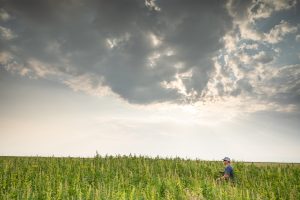
Fiber is hot among hemp producers looking for new markets – especially now that prices have bottomed out for hemp flower and biomass.
But the lack of fiber buyers and the sector’s immature supply chain have industry observers warning that hemp growers may get ahead of themselves and end up with yet another glut.
California-based outdoor apparel company Patagonia and the state of Colorado are hoping to help change that by bringing together farmers, machinery manufacturers, textile producers and hemp researchers.
“There’s nothing about political parties in hemp. It’s just a solid business opportunity, a solid environmental opportunity, good for farmers, good for our health, good for the economy, good for sustainability,” Colorado Gov. Jared Polis said in a video Patagonia released about the “Bring Hemp Home” project late last month.
Meeting of the minds

Jason Gonzales
Patagonia has long used hemp in its workwear products, sourcing it from China-based Hemp Fortex, which makes environmentally sustainable fibers.
“From there, the team had done a lot of visioning around how we can actually bring more hemp into the world from a planetary, mission-based standpoint,” Jason Gonzales, Patagonia’s head of marketing for workwear, told Hemp Industry Daily.
National legalization of hemp farming in 2018 kicked off the company’s collaboration with the state of Colorado to bring together hemp operators and help move the industrial hemp supply chain forward, Gonzales said.
“We’re getting calls every day from farmers who have been growing the hemp, (asking) ‘Can Patagonia buy my hemp fiber and put it in their clothes?” said Alexandra La Pierre, material developer with Patagonia.
“I want to tell them I can buy their fiber. But there are so few resources out there to direct them to: What is the correct way to grow? How should they plant? How long should it be in the ground? What is the type of seed to use?”

Alexandra LaPierre
At the same time, LaPierre said, she’s hearing manufacturers asking about hemp and how much Patagonia is using.
“We (said), ‘All right, we need to connect these pieces, and we need to have everyone sit down together in a room and talk to each other – not just through Patagonia,” she said.
“It was like a collaborative melding of the minds … bringing each piece of processing in there.”
The meeting also provided an opportunity to introduce the Colorado hemp industry to the global perspective of Hemp Fortex, La Pierre said.
“This gave us a unique opportunity to bring that legacy, and the knowledge that they have that they have, and the textiles they’ve been doing for hundreds of years and … see that knowledge get passed on and help jumpstart an industry that needed that leadership and mentorship,” she said.
Project goals
What resulted was the “Bring Hemp Home” project, a collaborative effort to:
- Elevate and raise awareness around industrial hemp.
- Increase the amount of hemp being grown in the United States.
- Help develop hemp-processing infrastructure.
As part of this, hemp researchers, farmers and processors are working to develop specifications for producing the best-quality hemp for fiber and processing it into the raw material that textile manufacturers need to create material.
Dion Oakes, co-owner of Wright-Oakes Farms in Colorado’s San Luis Valley, said farmers in the rich agricultural region near the New Mexico border are looking to diversify and are hungry for a crop that doesn’t use as much water.
A producer of hemp flower, grain and fiber for the past eight years, Oakes’ farm is conducting hemp variety trials and developing farming specifications for Colorado’s unique climate.
Formation Ag, a manufacturer of hemp machinery such as decorticators, is also working with Hemp Fortex on developing specifications for processing raw hemp material.
“We learned a lot about what we’re looking at for the future, but also a lot of it we’re still learning around the fiber quality,” Oakes told Hemp Industry Daily. “So was this was a baby step into something very huge.”
What the group learns in Colorado could likely be applied in other states as well, he said.
Oakes said the group is also looking at the fiber quality of dual-crop varieties, in addition to strictly fiber varieties, to provide more economic opportunities for farmers.
“We’ve got to make sure the farmer’s making money, and we’ve got to make sure this is a viable rotational crop,” Oakes said.
No buyer contracts… yet
Patagonia hasn’t signed any contract partnerships as a result of this project, Gonzales said.
“Patagonia doesn’t traditionally go in and buy retted hemp from farmers or even decorticate hemp from processors necessarily. But the purchase of the finished material on the end of it needs to happen, and that’s certainly where Patagonia is a contributor to these projects,” he said.
Separately, Patagonia plans to increase the amount of domestic hemp it uses in its workwear and other products in the next few years, Gonzales said.
Other apparel brands are watching Patagonia to learn about how it’s making hemp work. La Pierre said her hope is to include other brands in the project.
“We aren’t just cultivating a U.S. hemp industry to only have Patagonia make hemp workwear or hemp apparel. We want all the big brands to look at hemp.
“No. 1, it will help support farmers and keep them on their lands. …. The other is, what (hemp) does for the soil and carbon capture for fighting climate change,” La Pierre said.
“So, the more folks that can actually support hemp as a fiber, the better.”
The opportunity for the U.S to become a global supplier of good quality hemp – similar to the organic cotton grown in Texas – was a “guiding vision” for the state of Colorado to support the project, La Pierre said.
Replacing cotton is not the goal, however. The unique attributes of hemp and the opportunity it has to be a regenerative crop that offers carbon sequestration and phytoremediation of the soil make hemp an attractive addition to Patagonia’s natural fiber portfolio, La Pierre said.
“We’re not going to say we’re going to stop using organic cotton and replace every single product that we make with hemp,” she said.
“Our goal is to investigate and invest in sustainable fibers that are going to help us save our home planet.”
Laura Drotleff can be reached at [email protected]

